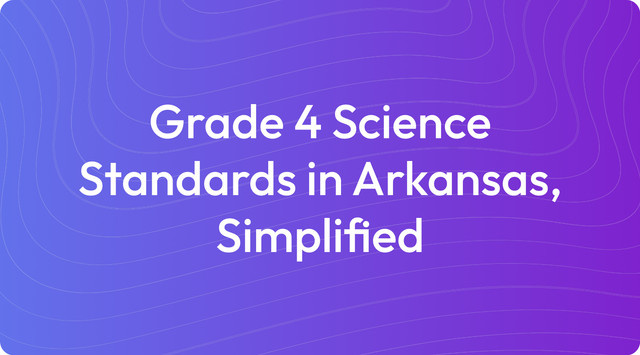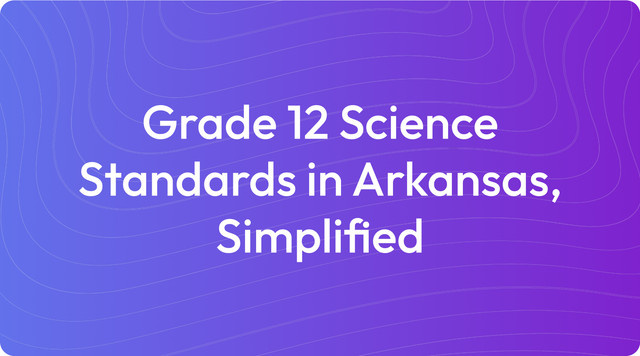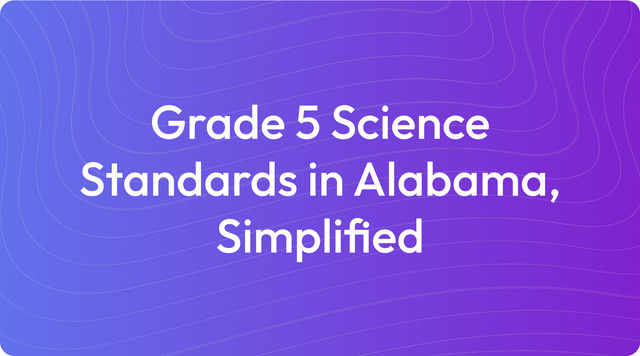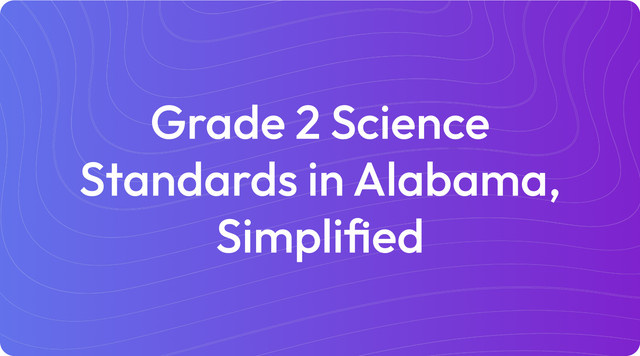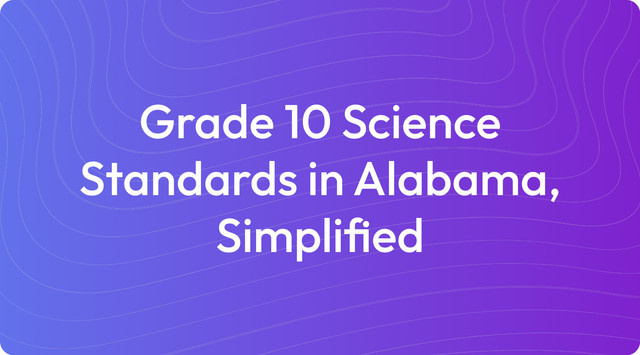Grade 12 Science Standards in California, Simplified
In Grade 12, California science includes advanced or elective topics. See easy summaries—read more on TeachShare!
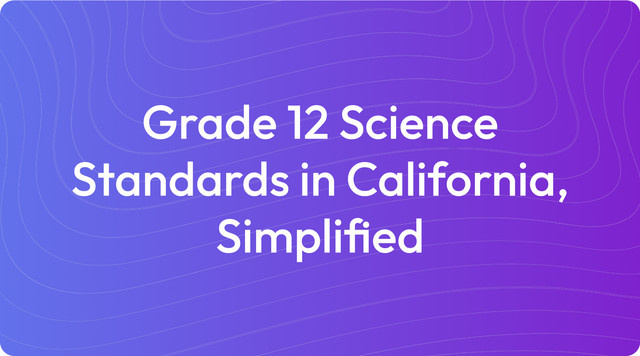
We know that working with state standards is a core part of a teacher's job, shaping everything from daily lessons to year-long curriculum planning. These frameworks can sometimes feel complex, but they provide the essential structure for student learning. Our goal is to offer tools and resources that help you connect these standards to practical, engaging classroom activities.
Education standards are learning goals that outline what students should know and be able to do at each grade level. For teachers, they provide clear benchmarks for student progress without prescribing specific teaching methods. For example, California’s Grade 12 science standards specify that students should be able to develop models of nuclear processes or explain how DNA structure determines protein function, guiding instruction toward college and career readiness.
What Are Grade 12 Science Standards in California?
The Grade 12 Science Standards in California, aligned with the California Next Generation Science Standards (CA NGSS), focus on advanced applications of science and engineering to prepare students for college and future careers. Here are the key areas of focus:
1. Physical Science (PS): Advanced Chemistry, Physics, and Energy
- PS1: Matter and Interactions
- Key Standard (HS-PS1-8): Develop and use models to describe nuclear processes, including fission, fusion, and radioactive decay.
- Key Standard (HS-PS1-5): Apply scientific principles to explain how factors like temperature and concentration impact reaction rates.
- PS3: Energy
- Key Standard (HS-PS3-3): Design, build, and refine a device that converts energy from one form to another.
- Key Standard (HS-PS3-5): Develop and use models of two objects interacting through electric or magnetic fields to illustrate the forces involved.
- PS4: Waves and Electromagnetic Radiation
- Key Standard (HS-PS4-3): Evaluate the effectiveness of different wave technologies (e.g., fiber optics, microwaves) for transmitting information.
2. Life Science (LS): Advanced Genetics, Evolution, and Ecosystem Dynamics
- LS1: From Molecules to Organisms
- Key Standard (HS-LS1-2): Develop and use a model to explain how the structure of DNA determines the structure of proteins and their role in specialized cells.
- LS2: Ecosystems, Energy, and Dynamics
- Key Standard (HS-LS2-4): Use mathematical representations to support claims for how energy flows and matter cycles within ecosystems.
- LS4: Biological Evolution
- Key Standard (HS-LS4-5): Evaluate evidence that environmental changes can lead to species adaptation, migration, or extinction.
3. Earth and Space Science (ESS): Earth’s Systems and Sustainability
- ESS2: Earth’s Systems
- Key Standard (HS-ESS2-6): Develop a model to describe the cycling of carbon among Earth’s spheres (atmosphere, biosphere, geosphere, hydrosphere).
- ESS3: Human Activity and Sustainability
- Key Standard (HS-ESS3-4): Evaluate or refine technological solutions to reduce human impacts on Earth’s natural systems (e.g., renewable energy systems).
4. Engineering, Technology, and Applications of Science (ETS): Problem-Solving
- ETS1: Engineering Design
- Key Standard (HS-ETS1-3): Evaluate solutions to complex real-world problems based on criteria, trade-offs, and constraints.
- Key Standard (HS-ETS1-4): Use computer simulations to model the impacts of proposed solutions to real-world problems.
The framework for these standards is guided by California's state content standards, which are built upon the foundational Next Generation Science Standards.
Key Tested Standards
For Grade 12 science in California, assessments are designed to measure a student's ability to apply advanced concepts from the CA NGSS. You can expect tests to focus on how students use scientific principles, analyze data, and engineer solutions to real-world problems. Below are the key tested standards across the four main scientific domains:
1. Physical Science (PS): Advanced Chemistry, Physics, and Energy
- HS-PS1-8: Nuclear Processes - Develop and use models to illustrate nuclear processes such as fission, fusion, and radioactive decay.
- HS-PS1-5: Reaction Rates - Apply scientific principles to explain how variables like temperature and concentration influence reaction rates.
- HS-PS3-3: Energy Conversion - Design, construct, and improve a device that transforms energy from one form to another.
- HS-PS4-3: Wave Technology - Assess the benefits and drawbacks of various wave-based technologies used for information transfer.
2. Life Science (LS): Genetics, Evolution, and Ecosystems
- HS-LS1-2: DNA and Proteins - Create a model to show how DNA’s structure dictates the structure of proteins and their functions in specialized cells.
- HS-LS3-2: Genetic and Environmental Influence - Use evidence to make and defend a claim about how genetic and environmental factors impact an organism's growth.
- HS-LS4-5: Adaptation and Extinction - Analyze evidence showing that changes in the environment can cause species to adapt, migrate, or become extinct.
3. Earth and Space Science (ESS): Climate, Sustainability, and Resources
- HS-ESS2-6: Carbon Cycle - Develop a model that describes how carbon cycles through the Earth's major systems.
- HS-ESS3-4: Sustainability and Technology - Assess or improve technological solutions designed to lessen human impact on natural systems.
- HS-ESS3-1: Natural Resources and Human Activity - Explain how human activities are shaped by the availability of natural resources, natural hazards, and climate change.
4. Engineering and Technology (ETS): Problem-Solving
- HS-ETS1-3: Evaluating Solutions - Evaluate a proposed solution to a complex real-world problem by weighing it against specific criteria and constraints.
- HS-ETS1-4: Simulating Solutions - Use computer simulations to model and predict the effects of proposed solutions to complex problems.
This information is based on guidance from the following sources:
Example Learning Objectives for Unit Planning
Learning objectives translate broad standards into specific, measurable goals for your students, making learning targets clear for everyone. They are written in student-friendly language and align with the three-dimensional learning approach of the NGSS, focusing on what students can do. Here are examples for two key Grade 12 Science standards in California:
Standard: HS-PS1-8
(Develop and use models to describe nuclear processes, including fission, fusion, and radioactive decay.)
Learning Objectives:
- I can describe what happens to an atom’s nucleus during fission, fusion, and radioactive decay.
- I can create a model to show how energy is released or absorbed during nuclear reactions.
- I can compare fission and fusion processes and explain where they occur in nature or technology (e.g., stars, nuclear power plants).
- I can analyze the benefits and risks of using nuclear energy for power generation.
Standard: HS-LS1-2
(Develop a model to explain how the structure of DNA determines the structure of proteins and how proteins carry out specialized functions in cells.)
Learning Objectives:
- I can explain how the sequence of DNA bases determines the structure of proteins.
- I can create a model to show how DNA is transcribed into RNA and translated into proteins.
- I can describe how proteins function in specialized cells to maintain life processes (e.g., enzymes, hormones).
- I can use evidence to explain how mutations in DNA might affect protein structure and function.
Key Changes & Updates
The Grade 12 Science Standards, guided by the California Next Generation Science Standards (CA NGSS), represent a fundamental shift in science instruction. The focus has moved from memorizing content to a more dynamic, hands-on approach centered on real-world problem-solving. This is structured around a “three-dimensional learning” model that weaves together Science and Engineering Practices (what students do), Crosscutting Concepts (how students think), and Disciplinary Core Ideas (what students know). For you, this means lessons are built around tangible phenomena, encouraging students to conduct experiments, analyze data, and build models to understand complex topics.
This updated framework also places a strong emphasis on integrating engineering design (ETS) into science education, asking students to create and evaluate solutions to practical challenges. Students are expected to construct arguments using evidence from their investigations and to think in terms of interconnected systems, whether they are exploring ecosystems, the carbon cycle, or energy conversion. Ultimately, these changes are designed to foster deeper engagement and critical thinking, building a solid foundation for students heading toward college or careers in STEM fields.
Create with TeachShare
We see the hard work you put into connecting with your students while meeting state requirements. Our platform was built to lighten that load, helping you create high-quality, standards-based science materials without the extra hours. We're here to be your partner in the classroom, giving you more time to focus on what you do best. Start creating standards-aligned instructional resources with TeachShare now.
Frequently Asked Questions
1. What key areas does Grade 12 Science cover under the NGSS framework?
Grade 12 science under the NGSS framework is built around advanced concepts in four key areas. Here’s what your students will be exploring:
- Physical Science: Nuclear processes, reaction rates, and wave technologies
- Life Science: DNA, genetic variation, and ecosystem dynamics
- Earth and Space Science: The carbon cycle, climate change, and sustainable resources
- Engineering Design: Creating and testing solutions for global challenges
2. How do the NGSS standards change the approach to teaching science?
The NGSS framework shifts the focus from memorization to application. The main differences from previous standards are:
- Three-Dimensional Learning: This combines scientific practices, core ideas, and overarching concepts in every lesson.
- Real-World Connections: Lessons are built around phenomena students can relate to, like climate change or modern energy systems.
- Active Exploration: Students learn by doing through experiments, modeling, and problem-solving.
- Integrated Engineering: Students apply scientific knowledge to design and test solutions for practical problems.
3. What kinds of assessments are used for NGSS-aligned Grade 12 Science?
Assessments are designed to show what students can do with their knowledge, not just what they remember. Common assessment methods include:
- Hands-On Investigations: Performing experiments to explore concepts like energy transfer or genetic variation.
- Model Creation: Building diagrams or simulations to explain complex systems like the carbon cycle or DNA-protein interactions.
- Data Analysis: Interpreting graphs and case studies related to topics like climate data or population genetics.
- Evidence-Based Arguments: Constructing scientific explanations supported by data.
4. Can you give some examples of classroom activities for these standards?
Of course. Here are a few examples of engaging activities that bring the Grade 12 standards to life:
- Modeling Nuclear Processes: Students can create models of fission and fusion to compare their energy outputs.
- Investigating Reaction Rates: They can design experiments to see how factors like temperature affect the speed of a chemical reaction.
- Mapping the Carbon Cycle: Students can develop a model showing how human activities disrupt the natural flow of carbon.
- Designing Sustainable Solutions: A project could involve designing and evaluating a method to reduce carbon emissions or conserve a local resource.
5. How does this curriculum prepare students for life after high school?
These standards directly connect classroom learning to skills needed for future success. By focusing on application, students are better prepared for college and careers. They learn to:
- Think critically by analyzing data and using evidence to form arguments.
- Build a strong foundation for college-level science courses and STEM careers.
- Understand how complex systems, like ecosystems or Earth's climate, work and respond to change.
- Apply scientific principles to solve real-world problems, from public health to resource management.
Answer


